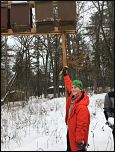 On Saturday, February 2, 9 scouts from BSA Troop 102 visited Upham Woods to complete their Environmental Science Merit badge. This merit badge is required to achieve the rank of Eagle Scout, so it is one of the most difficult of the 137 badges. Through their hard work and preparation, all nine were able to complete the merit badge that day.
On Saturday, February 2, 9 scouts from BSA Troop 102 visited Upham Woods to complete their Environmental Science Merit badge. This merit badge is required to achieve the rank of Eagle Scout, so it is one of the most difficult of the 137 badges. Through their hard work and preparation, all nine were able to complete the merit badge that day.
The first activity of the morning was a discussion on ecosystems and related terminology, including population, community, niche, habitat, endangered species, threatened species, and several associated terms.
Following this discussion, they conducted an experiment to observe the impacts of thermal pollution. The Boy Scouts used the scientific method to hypothesize and observe how minnows would react when they faced abrupt warming and cooling of their environment. The scouts observed that these rapid changes can significantly impact the health of cold-blooded animals, as their bodies go into shock. Though these changes can be disastrous for some species, other species may benefit from them. In this case it was Egor, the Upham Woods snapping turtle, who ate the fish after the experiment.
The last activity before lunch was a hike to Cabin Hill to see the bat houses. Using the Thermal Imaging camera from the DOTS kit, the scouts could observe the warming abilities of the sun on the bat houses.
After lunch the scouts went on a Naturalist-led snowshoe hike across Peanut Butter Mountain and along the South Beach Trail. From the end of the trail, the scouts could see all the way to the Pre-Cambrian Sandstone cliffs that form the Narrows of the Wisconsin River. Every geological feature visible on our hike was a direct result of the erosion that carved the Wisconsin Dells. On the way back up the trail, the scouts stopped to observe the characteristics of two different outdoor study areas.
The Environmental Science merit badge requires the scouts to research three careers in the field of Environmental Science. When the scouts returned from their hike, they interviewed two of the Naturalists and learned about the college education, job training, and environmental education experience required to work at Upham Woods.
The final activity was writing environmental impact statements to determine what negative impacts a construction project could have. In this case, the project was the new Welcome Center that will be constructed at Upham Woods. This was a great activity to end with because the scouts had an opportunity to apply their knowledge of how human activities can affect the environment, and what can be done to prevent negative impacts from humans.
Boy Scout Troop 102 had a terrific time at Upham Woods, and Upham Woods was more than happy to help them earn their Environmental Science Merit Badge.



